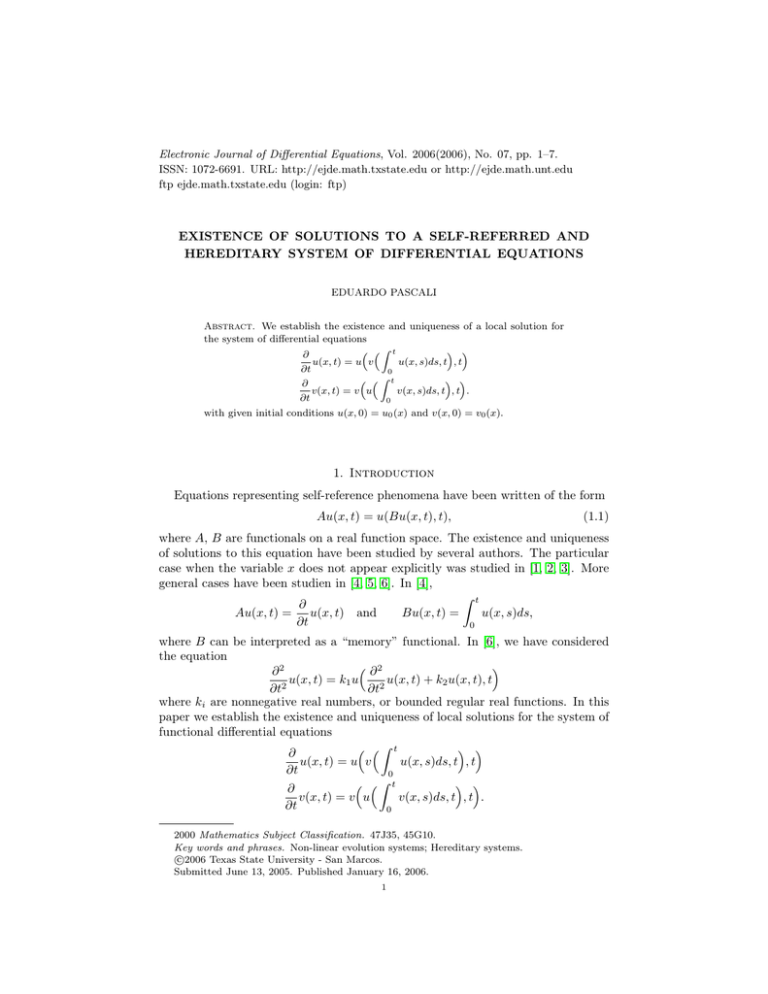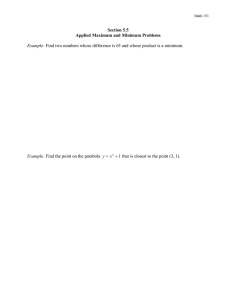Electronic Journal of Differential Equations, Vol. 2006(2006), No. 07, pp.... ISSN: 1072-6691. URL: or
advertisement

Electronic Journal of Differential Equations, Vol. 2006(2006), No. 07, pp. 1–7. ISSN: 1072-6691. URL: http://ejde.math.txstate.edu or http://ejde.math.unt.edu ftp ejde.math.txstate.edu (login: ftp) EXISTENCE OF SOLUTIONS TO A SELF-REFERRED AND HEREDITARY SYSTEM OF DIFFERENTIAL EQUATIONS EDUARDO PASCALI Abstract. We establish the existence and uniqueness of a local solution for the system of differential equations “ “Z t ” ” ∂ u(x, t) = u v u(x, s)ds, t , t ∂t 0 “ “Z t ” ” ∂ v(x, t) = v u v(x, s)ds, t , t . ∂t 0 with given initial conditions u(x, 0) = u0 (x) and v(x, 0) = v0 (x). 1. Introduction Equations representing self-reference phenomena have been written of the form Au(x, t) = u(Bu(x, t), t), (1.1) where A, B are functionals on a real function space. The existence and uniqueness of solutions to this equation have been studied by several authors. The particular case when the variable x does not appear explicitly was studied in [1, 2, 3]. More general cases have been studien in [4, 5, 6]. In [4], Z t ∂ Au(x, t) = u(x, t) and Bu(x, t) = u(x, s)ds, ∂t 0 where B can be interpreted as a “memory” functional. In [6], we have considered the equation ∂2 ∂2 u(x, t) = k u u(x, t) + k u(x, t), t 1 2 ∂t2 ∂t2 where ki are nonnegative real numbers, or bounded regular real functions. In this paper we establish the existence and uniqueness of local solutions for the system of functional differential equations Z t ∂ u(x, t) = u v u(x, s)ds, t , t ∂t 0 Z t ∂ v(x, t) = v u v(x, s)ds, t , t . ∂t 0 2000 Mathematics Subject Classification. 47J35, 45G10. Key words and phrases. Non-linear evolution systems; Hereditary systems. c 2006 Texas State University - San Marcos. Submitted June 13, 2005. Published January 16, 2006. 1 2 E. PASCALI EJDE-2006/07 This system can be considered a model for the evolution of two reasonings, as follows: If x is an event, t is the time, and u(x, t), v(x, t) are two reasonings about Rt x at time t, then the term v( 0 u(x, s)ds, t) can be considered as a “criticism” of v over all previous reasonings of u on x, up to time t. 2. The main result In this section we prove the following theorem. Theorem 2.1. Let u0 , v0 : R → R be bounded and Lipschitz continuous. Then, there exist T0 > 0 and two real bounded and Lipschitz continuous functions u∞ , v∞ : R × [0, T0 ] → R such that Z t ∂ u∞ (x, t) = u∞ v∞ u∞ (x, τ )dτ, t , t ∂t 0 Z t ∂ v∞ (x, t) = v∞ u∞ v∞ (x, τ )dτ, t , t ∂t 0 u∞ (x, 0) = u0 (x), v∞ (x, 0) = v0 (x) for all x ∈ R and all t ∈ [0, T0 ]. Moreover the functions u∞ , v∞ are unique. Proof. Let u0 , v0 be given, and let L0 , M0 > 0 be such that |u0 (x) − u0 (y)| ≤ L0 |x − y|, |v0 (x) − v0 (y)| ≤ M0 |x − y|. for all x, y ∈ R. Define the sequences of functions (un )n , (vn )n , for all x ∈ R and t > 0, as follows: Z u1 (x, t) = u0 (x) + t u0 v0 (u0 (x)τ ) dτ, 0 t v1 (x, t) = v0 (x) + v0 u0 (v0 (x)τ ) dτ, 0 Z t Z τ un+1 (x, t) = u0 (x) + un vn un (x, s)ds, τ , τ dτ, 0 0 Z t Z τ vn+1 (x, t) = v0 (x) + vn un vn (x, s)ds, τ , τ dτ. Z 0 0 Notice that |u1 (x, t) − u0 (x)| ≤ ku0 k∞ t ≡ A1 (t) (2.1) |v1 (x, t) − v0 (x)| ≤ kv0 k∞ t ≡ B1 (t), (2.2) EJDE-2006/07 SELF-REFERRED AND HEREDITARY SYSTEM for all x ∈ R, t > 0. Moreover, using (2.1), (2.2) we have |u2 (x, t) − u1 (x, t)| Z t Z τ Z t u0 (v0 (u0 (x)τ ))dτ u1 (x, s)ds, τ )τ )dτ − u1 (v1 ( ≤ 0 0 0 Z τ Z t Z τ Z t u1 (v1 ( u1 (x, s)ds, τ )τ )dτ − u0 (v1 ( u1 (x, s)ds, τ ))dτ ≤ 0 0 0 0 Z τ Z t Z t u0 (v1 ( u1 (x, s)ds, τ ))dτ − u0 (v0 (u0 (x)τ ))dτ + 0 0 0 Z t Z t Z τ u1 (x, s)ds, τ ) − v0 (u0 (x)τ )dτ ≤ ku0 k∞ τ dτ + L0 v1 ( 0 0 0 Z τ Z t Z t h Z τ u1 (x, s)ds, τ ) − v0 ( u1 (x, s)ds) ≤ ku0 k∞ τ dτ + L0 v1 ( 0 0 0 0 Z τ i + v0 ( u1 (x, s)ds) − v0 (u0 (x)τ ) dτ 0 Z t Z τ h i ≤ ku0 k∞ τ + L0 kv0 k∞ τ + M0 ku0 k∞ sds dτ 0 0 Z τ Z t h i = A1 (τ ) + L0 B1 (τ ) + M0 A1 (s)ds dτ 0 0 for all x ∈ R, and all t > 0. In a similar way we prove Z t Z |v2 (x, t) − v1 (x, t)| ≤ B1 (τ ) + M0 [A1 (τ ) + L0 0 τ B1 (s)ds] dτ 0 for all x ∈ R, and all t > 0. We have also Z t |u1 (x, t) − u1 (y, t)| ≤ L0 |x − y| + L20 M0 |x − y|τ dτ 0 Z t = L0 + L20 M0 τ dτ |x − y| ≡ L1 (t)|x − y|; 0 Z t |v1 (x, t) − v1 (y, t)| ≤ M0 |x − y| + L0 M02 |x − y|τ dτ 0 Z t = M0 + L0 M02 τ dτ |x − y| ≡ M1 (t)|x − y|. 0 It is easy to prove the inequality Z t Z τ h i 1 d |u2 (x, t) − u2 (y, t)| ≤ L0 + M1 (τ ) ( L1 (s)ds)2 dτ |x − y| . 2 dτ 0 0 Set now Z t L2 (t) ≡ L0 + 0 1 d M1 (τ ) 2 dτ Z τ L1 (s)ds 2 dτ. 0 Moreover, we remark that h Z |v2 (x, t) − v2 (y, t)| ≤ M0 + 0 t 1 d L1 (τ ) 2 dτ Z τ M1 (s)ds 0 2 i dτ |x − y|, 3 4 E. PASCALI EJDE-2006/07 and set Z M2 (t) ≡ M0 + t L1 (τ ) 0 1 d 2 dτ Z τ M1 (s)ds 2 dτ. 0 We define for all n and t > 0: Z t Z τ An+1 (t) = An (τ ) + Ln−1 (τ )[Bn (τ ) + Mn−1 (τ ) An (s)ds] dτ ; 0 0 Z t Z τ Bn+1 (t) = Bn (τ ) + Mn−1 (τ )[An (τ ) + Ln−1 (τ ) Bn (s)ds] dτ ; 0 0 Z t Z τ 1 d 2 Mn (τ ) Ln+1 (t) = L0 + Ln (s)ds) dτ ; ( 2 dτ 0 0 Z t Z τ 1 d Ln (τ ) Mn+1 (t) = M0 + Mn (s)ds)2 dτ. ( 2 dτ 0 0 By induction, it is easily to prove that for all x ∈ R, t > 0, |un+1 (x, t) − un (x, t)| ≤ An+1 (t) (2.3) |vn+1 (x, t) − vn (x, t)| ≤ Bn+1 (t) (2.4) and, for all x, y ∈ R, t > 0, |un+1 (x, t) − un+1 (y, t)| ≤ Ln+1 (t)|x − y| (2.5) |vn+1 (x, t) − vn+1 (y, t)| ≤ Mn+1 (t)|x − y| (2.6) In a very simple way we can prove also that for all x ∈ R, t > 0, |un+1 (x, t)| ≤ et ku0 k∞ t |vn+1 (x, t)| ≤ e kv0 k∞ Since 0 ≤ L1 (t) = L0 + M0 L20 t2 /2 0 ≤ M1 (t) = M0 + L0 M02 t2 /2, we can choose T0 > 0 and h > 0 such that 2h < 1 and for all t ∈ [0, T0 ]: t2 ≤ 1, 2 t2 M02 ≤ 1, 2 t2 (M0 + L0 )3 ≤ M0 ∧ L0 , 2 L20 t2 ≤ h. 2 Then 0 ≤ L1 (t), M1 (t) ≤ M0 + L0 ≡ K0 for all t ∈ [0, T0 ]. From the previous definitions we deduce: Z t Z 2 1 d τ t2 0 ≤ L2 (t) ≤ L0 + M1 (τ ) L1 (s)ds dτ ≤ L0 + K03 , 2 dτ 0 2 0 Z t Z τ 1 d t2 0 ≤ M2 (t) ≤ M0 + L1 (τ ) ( M1 (s)ds)2 dτ ≤ M0 + K03 . 2 dτ 0 2 0 0 ≤ (M0 + L0 + 1)t + (M0 + L0 )2 (2.7) (2.8) EJDE-2006/07 SELF-REFERRED AND HEREDITARY SYSTEM 5 Then we have 0 ≤ L2 (t), M2 (t) ≤ K0 ∀t ∈ [0, T0 ], and hence, by induction, 0 ≤ Ln (t), Mn (t) ≤ M0 + L0 ≡ K0 ∀t ∈ [0, T0 ]. (2.9) From the definitions of An e Bn , we deduce Z τ Z t An (s)ds dτ ; 0 ≤ An+1 (t) ≤ An (τ ) + K0 Bn (τ ) + K02 0 0 Z τ Z t Bn (s)ds dτ. 0 ≤ Bn+1 (t) ≤ An (τ ) + K0 An (τ ) + K02 0 0 For the continuity of An and Bn in [0, T0 ], we deduce: t2 0 ≤ An+1 (t) ≤ kAn k∞ t + K02 + K0 tkBn k∞ ; 2 t2 0 ≤ Bn+1 (t) ≤ kBn k∞ t + K02 + K0 tkAn k∞ . 2 Now, for all t ∈ [0, T0 ], 0 ≤ An+1 (t); Bn+1 (t) ≤ h(kAn k∞ + kBn k∞ ) Hence, taking the supremum over t and adding the inequalities, we deduce that the series X (kAn k∞ + kBn k∞ ) P P is convergent; then the same holds for both the series kAn k∞ and kBn k∞ . We remember that L∞ (R × [0, T0 ]; R) is a complete metric space with respect to lagrangian metric; then from the inequalities (2.3), (2.4), applying the BanachCaccioppoli theorem, we have that (un )n and (vn )n are Cauchy sequences. Hence there exist two real functions u∗ and v ∗ , defined in R × [0, T0 ] such that: (un )n is uniformly convergent to u∗ and (vn )n is uniformly convergent to v ∗ in R × [0, T0 ]; moreover, from (2.7),(2.8) and (2.9), u∗ and v ∗ are Lipschitz continuous in all the variables. We remark that, for all n ∈ N , x ∈ R, t ∈ [0, T0 ]: Z t Z t ∗ un (x, τ )dτ, t , t − u v ∗ u∗ (x, τ )dτ, t , t un vn 0 0 ≤ kun − u∗ k∞ + K0 kvn − v ∗ k∞ + K02 tkun − u∗ k∞ . Then u∗ and v ∗ verify that for all x ∈ R and t ∈ [0, T0 ]: Z t Z τ ∗ u (x, t) = u0 (x) + u∗ v ∗ ( u∗ (x, s)ds, τ ), τ dτ, 0 0 Z t Z τ v ∗ (x, t) = v0 (x) + v ∗ u∗ ( v ∗ (x, s)ds, τ ), τ dτ, 0 0 6 E. PASCALI EJDE-2006/07 respectively. Let us now prove the uniqueness. Let (u∗ , v∗ ) be another pair of solutions and remark that: Z τ Z τ ∗ ∗ u∗ (x, s)ds, τ ), τ − u∗ v∗ ( u∗ (x, s)ds, τ ), τ u v ( 0 0 Z τ Z τ u∗ (x, s)ds, τ ) − v∗ ( u∗ (x, s)ds, τ ) ≤ K0 v ∗ ( 0 0 Z τ Z τ ∗ u∗ (x, s)ds, τ ), τ u∗ (x, s)ds, τ ), τ − u∗ v∗ ( + u v∗ ( 0 0 Z τ Z τ u∗ (x, s)ds − u∗ (x, s)ds ≤ K 0 K0 0 0 Z τ Z τ + v ∗ ( u∗ (x, s)ds, τ ) − v∗ ( u∗ (x, s)ds, τ )) + ku∗ − u∗ k∞ 0 0 ≤ (1 + K02 t)ku∗ − u∗ k∞ + K0 kv ∗ − v∗ k∞ . Therefore, t2 )ku∗ − u∗ k∞ + K0 tkv ∗ − v∗ k∞ . 2 In a similar way we can prove the estimates: |u∗ (x, τ ) − u∗ (x, τ )| ≤ (t + K02 t2 )ku∗ − u∗ k∞ + K0 tkv ∗ − v∗ k∞ , 2 t2 |v ∗ (x, τ ) − v∗ (x, τ )| ≤ (t + K02 )kv ∗ − v∗ k∞ + K0 tku∗ − u∗ k∞ . 2 |u∗ (x, τ ) − u∗ (x, τ )| ≤ (t + K02 Then |u∗ (x, τ ) − u∗ (x, τ )| ≤ (t + K02 t2 + K0 t) max(ku∗ − u∗ k∞ ; kv ∗ − v∗ k∞ ), 2 |v ∗ (x, τ ) − v∗ (x, τ )| ≤ (t + K02 t2 + K0 t) max(kv ∗ − v∗ k∞ ; ku∗ − u∗ k∞ ). 2 and 2 From (t + K02 t2 + K0 t) ≤ h < 1, we have max(ku∗ − u∗ k∞ ; kv ∗ − v∗ k∞ ) < h max(ku∗ − u∗ k∞ ; kv ∗ − v∗ k∞ ). Then the uniqueness follows and the proof is complete. 3. Some Open Problems The previous results and the proposed type of systems can be investigated and generalized in many different directions. In what follows, we give some of the problems whose investigation seems to be interesting. (A) The first problem is to investigate the existence of global solutions, also for Lipschitzian and bounded initial data. (B) It could be more difficult to establish existence and uniqueness for data u0 , v0 bounded and uniformly continuous (or simply continuous). Moreover, when the global existence is guaranteed, an interesting problem can be to give particular condition on data u0 , v0 such that there exists T ∗ > 0 for which u(x, t) = v(x, t) for all x ∈ R and t ≥ T ∗ . EJDE-2006/07 SELF-REFERRED AND HEREDITARY SYSTEM 7 References [1] E. Eder: The functional-differential equation x0 (t) = x(x(t)), J. Diff. Equat. 54 (1984), no. 3, 399-400. [2] Jan-Guo Si and Sui Sun Cheng: Analytic solutions of a functional differential equation with state dependent argument, Taiwanese J. Math., 1 (1997), no. 4, 471-480. [3] Jan-Guo Si, Xin-Ping Wang and Sui Sun Cheng: Analytic solutions of a functionaldifferential equation with a stese derivative dependent delay, Aequ. Mathem., 57 (1999) no. 1, 75-86. [4] M. Miranda (Jr), E. Pascali: On a type of evolution of self-referred and hereditary phenomena, Aequ. Mathem. (in press). [5] M. Miranda (Jr), E. Pascali: Other classes of self-referred equations, (submitted). [6] M. Miranda (Jr), E. Pascali: On a class of differential equations with self-reference, Rend. Mat., serie VII, vol.25, Roma(2005), 155-164. [7] V. Volterra: Opere Matematiche: Memorie e note, Vol. V, 1926-1940, Accademia Nazionale dei Lincei, Rome 1962. Eduardo Pascali Department of Mathematics “Ennio De Giorgi”, University of Lecce, C. P. 193, 73100, Lecce, Italy E-mail address: eduardo.pascali@unile.it







